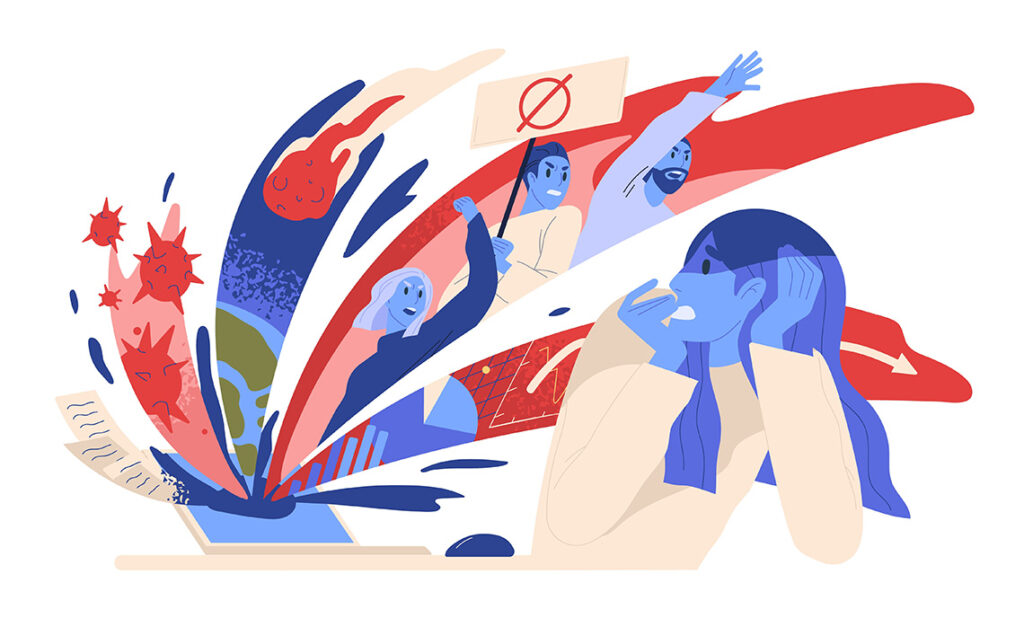When you come across news on climate change, how do you feel? Are you afraid of the future you or/and your children will live in? Does the feeling hopeless or helpless speak to you?
Welcome to what we call “eco-anxiety”! It is reported that over 80% of young people are at least moderately worried about the future of our planet
Greta Cappello, Kuzma Glazovskii, Alexandra Podvarkova, Arthur Sahaghian, Aditya Shrikrishna Pande and Bitthal Singh Yadav are six ESCP Master in Management students who participated in the “Design Fiction for Sustainable Futures” course at ESCP, organised by the ESCP Circular Economy Chair, in partnership with Onepoint.
This 30-hour elective path allowed them to explore the role of media in achieving a sustainable society. In the scope of the course, they decided to take a closer look at eco-anxiety and what the media can do about it.
What is eco-anxiety exactly?
While climate change – or the climate crisis – is a reality that tangibly threatens the future of our planet and of humanity (remember the fires in Australia, cyclones, heatwaves…), it also impacts us psychologically, generating anxiety and distress.
This phenomenon is called “eco-anxiety” or “solastalgia”, and it is a growing concern among psychologists around the world.
Although not considered a disease – yet – eco-anxiety refers to psychological disorders caused by heightened distress over the climate emergency: increase in global pollution, extreme weather phenomena, loss of biodiversity, water shortages, and deforestation, among others.
The American Psychology Association (APA) describes eco-anxiety as “the chronic fear of environmental cataclysm that comes from observing the seemingly irrevocable impact of climate change and the associated concern for one’s future and that of next generations”.
As of today, there is no data or survey to measure how much people suffer from eco-anxiety, but experts say that it will grow exponentially with the increasing number of climate-related incidents. In 2017, the APA released a first report on the psychological impact of climate change which has helped to raise awareness of the problem.
Eco-anxiety, finally putting a word on what we’d been feeling
In the second edition of the “Design Fiction for Sustainable Futures” course, we heard from a variety of prestigious guests throughout the semester, including Wolfgang Blau, Co-Founder of Oxford Climate Journalism Network, who stressed the growing role of the media in the climate crisis and Christophe Cassou, researcher at the French National Centre for Scientific Research (CNRS) and member of the Intergovernmental Panel on Climate Change (IPCC).
These experts introduced us to the concept of eco-anxiety, which led to a moment of revelation for a number of our members who were relieved to finally be able to put a word on what they had been feeling for months, or years.
Interestingly, the common denominator between their experiences was social media. Many of the students claimed to experience negative impacts on their mental health after using the platforms, especially after seeing climate-related topics.
Everyone’s social media feed is ruled by the same algorithm, according to what seems to be simple rules: the more you look for a topic, the more the algorithm will suggest related content. The more you follow and interact with accounts about a given topic, the more the algorithm is going to lock you into a “filter-bubble”.
To understand how social media is affecting the way we consume content related to climate change and the impact on our mental health, we created an experimental Instagram account and “trained” it to display different kinds of posts: from the highly-concerned climate change-related feed to a “softer” feed that prioritised puppies and kittens, for example.
Traditional media have a role to play in encouraging climate action & mitigating eco-anxiety
Social media are extremely powerful and tend to polarise opinions. Need we mention the Cambridge Analytica affair, which revealed to the world the influence of social media on Brexit and the US’s 2016 elections.
More recently, the movie “Don’t Look Up” (2021) also raised awareness on how media – and social media – contribute to inactiveness towards climate change.
But the relationship also works the other way around. We can no longer deny that social media platforms are critical news sources and, as such, they have the power to encourage action against climate change. Taking action, and counteracting our feeling of helplessness, is a key way to reduce eco-anxiety.
A recent study from Pew Research Center, revealed that around 71% of American people get at least some of their news from social media platforms.
This is why accuracy is important. To ensure that what users see is correct, we need traditional media to do their part. Despite their complex relationship with social networks, traditional media remain a primary source for quality and fact-checked news on these platforms.
Traditional media’s ability to do their part, however, is challenged by the mechanisms that govern our social networks.
The editorial rules have changed with social media. While good sales were often synonymous with quality content back in the day, content today is mainly judged by new metrics: the number of likes and the number of times the content was shared.
Buzz, or a content’s ability to “go viral”, is at play here, and not necessarily linked with quality.
For traditional media to play their part in fighting ignorance and misinformation with facts, challenges like this will need to be addressed.
How can information on climate change, which is not inherently buzz- friendly, rise above the noise and encourage action?
Journalism has a pedagogical role, especially about climate. Because climate-related news are often scary and can lead to eco-anxiety, and inaction, we need a new kind of journalism oriented towards solutions, talking about local initiatives, close to readers, held by people to whom readers can identify themselves with.
We think this can be a viable alternative to media catastrophism that will instead lead people to act and make their voices heard.
That’s the challenge our generation needs to solve.
